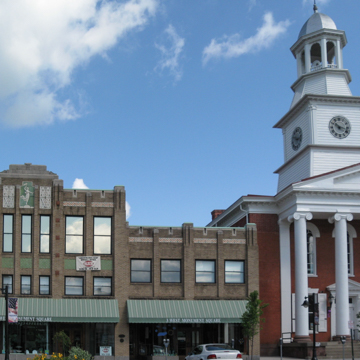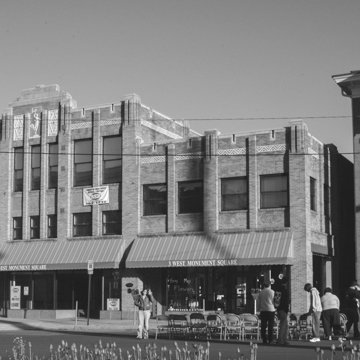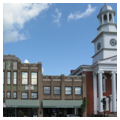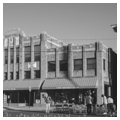Further evidence of the mini-metropolitan status of Lewistown is the Montgomery Ward building, one of the early department stores built by the Chicago-based retailer. Established in 1872, Montgomery Ward was exclusively a mail-order business for rural customers until 1926 when the company opened its first store in Plymouth, Indiana. By 1929, the company had constructed 531 stores including the one in Lewistown. Typically two or three stories in height and constructed of steel frame sheathed with buff or brown brick, Ward's chain stores had subdued Art Deco styling that fit unobtrusively onto the Main Streets of small towns. Each local variation had a facade with parapets and pilasters, patterned glazed tiles, and ornamental terracotta panels with the store logo, an Art Nouveau female personification of The Spirit of Progress representing the monumental statue created by J. Massey Rhind for the Montgomery Ward Tower, the flagship store in Chicago designed by Hugh Garden (Schmidt, Garden and Martin) in 1900. The Lewistown store designed by Royer and Witman of York, Pennsylvania, has a crenellated parapet with an Art Deco pediment bracketed by corbeled pilasters. Two vertical terra-cotta plaques with scrollwork flank the company logo in the center of the upper story. Panels of green glazed tiles beneath the square mezzanine windows complement the green background of the logo and the green awnings above the store's two recessed entranceways set between glass display windows. Bands of chevron-patterned glazed tiles above the upper-story window bays unite the store to the adjacent office, which has herringbone brick panels beneath the second-story windows. Since Montgomery Ward closed its retail division in 2001, the Lewistown building has been used for boutique retail. It is currently the only Montgomery Ward building in Pennsylvania on the National Register.
You are here
Montgomery Ward Building
If SAH Archipedia has been useful to you, please consider supporting it.
SAH Archipedia tells the story of the United States through its buildings, landscapes, and cities. This freely available resource empowers the public with authoritative knowledge that deepens their understanding and appreciation of the built environment. But the Society of Architectural Historians, which created SAH Archipedia with University of Virginia Press, needs your support to maintain the high-caliber research, writing, photography, cartography, editing, design, and programming that make SAH Archipedia a trusted online resource available to all who value the history of place, heritage tourism, and learning.


















